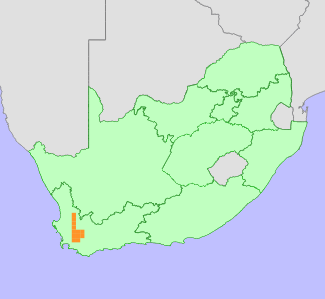|
Scientific Name | Protea effusa E.Mey. ex Meisn. |
Higher Classification | Dicotyledons |
Family | PROTEACEAE |
Synonyms | Protea marlothii E.Phillips |
Common Names | Scarlet Sugarbush (e) |
National Status |
Status and Criteria | Near Threatened B1ab(iii)+2ab(iii) |
Assessment Date | 2020/06/08 |
Assessor(s) | A.G. Rebelo, H. Mtshali & L. von Staden |
Justification | Protea effusa is a range-restricted species with an extent of occurrence (EOO) of 6419 km², and an area of occupancy (AOO) of 216 km². It occurs as small, severely fragmented subpopulations. Small subpopulation sizes may indicate that they are remnants of formerly larger subpopulations, but monitoring is needed to establish whether any significant declines are taking place. A small past population reduction is suspected based on habitat loss due to agriculture. There are alien invasive plants in low densities, but they are unlikely to be causing any population decline at present. Currently the population is suspected to be stable. It therefore nearly meets the thresholds for listing as Vulnerable under criterion B and is listed as Near Threatened. |
Distribution |
Endemism | South African endemic |
Provincial distribution | Western Cape |
Range | This species is endemic to the mountains of the Western Cape Province, South Africa, occurring from Koue Bokkeveld to Naudesberg and Riviersonderend. |
Habitat and Ecology |
Major system | Terrestrial |
Major habitats | South Hex Sandstone Fynbos, North Hex Sandstone Fynbos, Winterhoek Sandstone Fynbos, Cederberg Sandstone Fynbos, Western Altimontane Sandstone Fynbos, Olifants Sandstone Fynbos, South Langeberg Sandstone Fynbos, North Langeberg Sandstone Fynbos, North Sonderend Sandstone Fynbos, Hawequas Sandstone Fynbos |
Description | It grows on exposed rocky ridges, 1000-2000 m. Mature individuals are killed by fires, and only seeds survive. Wind-dispersed seeds are stored in fire-resistant inflorescences, and released after fires. It is pollinated by rodents. |
Threats |
| Subpopulations on the Hex River and Groot Winterhoek mountains are suspected to be declining due to too frequent fires. Subpopulations at Gydoberg and Gydo Pass are threatened by ongoing habitat loss to fruit orchards. Reasons for small, restricted subpopulations elsewhere in the species' range are not known.
Field observations noted presence of alien invasive plants in low densities at Hottentots Holland Mountains, Du Toit's Kloof Mountains, Riviersonderend Mountains, and some parts of the Langeberg. These could outcompete this species in the future if left unmanaged. |
Population |
Most known subpopulations are isolated on summit peaks. More than a quarter of subpopulations have fewer than five plants, and appear to be remnants of former more extensive subpopulations, but it is not known for certain whether this species is declining and what may be causing the decline. Only 13% of subpopulations have more than 100 plants.
|
Population trend | Unknown |
Conservation |
| Present in Groot Winterhoek, Fonteintjiesberg, Haweqwa, Theewaters, Wittebrug, Witsenberg and Patryskloof nature reserves. |
Notes |
| The majority of subpopulations are prostrate plants. However, erect forms occur at Gydo Pass and along the Gydoberg. The possibility that these are hybrid populations with Protea recondita, or hybrids between Protea recondita and Protea pendula, should be investigated further. |
Assessment History |
Taxon assessed |
Status and Criteria |
Citation/Red List version | | Protea effusa E.Mey. ex Meisn. | NT A4c | Raimondo et al. (2009) | |
Bibliography |
Goldblatt, P. and Manning, J.C. 2000. Cape Plants: A conspectus of the Cape Flora of South Africa. Strelitzia 9. National Botanical Institute, Cape Town.
Raimondo, D., von Staden, L., Foden, W., Victor, J.E., Helme, N.A., Turner, R.C., Kamundi, D.A. and Manyama, P.A. 2009. Red List of South African Plants. Strelitzia 25. South African National Biodiversity Institute, Pretoria.
Rebelo, T. 2001. Sasol Proteas: A field guide to the proteas of southern Africa. (2nd ed.). Fernwood Press, Vlaeberg, Cape Town.
|
Citation |
| Rebelo, A.G., Mtshali, H. & von Staden, L. 2020. Protea effusa E.Mey. ex Meisn. National Assessment: Red List of South African Plants version 2024.1. Accessed on 2025/12/25 |
 Comment on this assessment
Comment on this assessment

